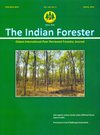Provenance Trial of Dalbergia sissoo Roxb
DOI:
https://doi.org/10.36808/if/2016/v142i3/90956Keywords:
Dalbergia sissoo, Provenance, Seed Source.Abstract
Around 55 provenances / seed sources of Dalbergia sissoo Roxb. were collected from vast expanses of India and Nepal as part of National Provenance Trial by ICFRE in 1994 - 1995, and 40 seed sources were planted in Basantar Bela, Samba district of Jammu region of J&K in July 1995 in a randomized complete block design. The seed sources have been evaluated during January 2010 for survival and growth parameters. It was observed that the parameters of diameter, height and volume over bark varied significantly with regard to seed sources, but not with regard to replications. The wide variations observed in the trial cannot be explained unambiguously from climatic differences between the locations of these seed sources alone, as evidenced by correlation studies. It was further established that seeds from Mirzapur, Nepal and Pratapgarh manifested distinct advantages concerning the survival, height, diameter and volumes of the stems, thus demonstrating their utility in bolstering mass plantation in the north western Indian region and elsewhere. Further studies appear obligatory to apprehend this indication.References
Arya S., Bisht R.P., Tomar R., Toky O.P. and Harris P.J.C. (1995). Genetic variation in minerals, crude protein and structural carbohydrates of foliage in provenances of young plants of Prosopis cineraria (L.) Druce in India. Agroforestry Systems, 29(1): 1-7.
Bangarwa K.S. and Singh V.P. (1998). Phenotypic variations in natural populations of Dalbergia sissoo Roxb. Biodivers. Forest Spec., 171-182.
Bohre P., Chaubey O.P. and Singhal P.K. (2012). Biomass accumulation and carbon sequestration in Dalbergia sissoo Roxb. International Journal of Bio-Science and Bio-Technology, 4(3):29-44.
Carnegie A.J., Keane P.J., Ades P.K. and Smith I.W. (1994). Variation in susceptibility of Eucalyptus globulus provenances to Mycosphaerella leaf disease. Canadian Journal of Forest Research, 24(9): 1751-1757.
Finkeldey R. and Hattemer H.H. (2006). Tropical Forest Genetics. Springer Berlin Heidelberg.
Gera M., Gera N. and Ginwal H.S. (2004). Performance of eleven seed source/provenances of Albizia procera (Roxb.) under semi-arid region of central India. Ann. of For., 12(1): 73-80.
Gera M., Gera N., Agarwal R. and Gupta B.N. (2002). Genetic variation in biochemical contents in foliage of twenty seed sources of Dalbergia sissoo Roxb. Indian Forester; 128 (7):726-737.
Khalil M.A.K. (1986). Variation in seed quality and some juvenile characters of white spruce. Picea Glauca, 2-3.
Kumar N. and Toky O.P. (1993). Variations in pod and seed size among Albizia lebbek provenances. Nitrogen Fixing Tree Res. Reports., 2: 64-67.
Nair P.K.R. and Fernandes E. (1984). Agroforestry as an alternative to shifting cultivation.In: Improved production system as an alternative to shifting cultivation FAO Soil Bulletin 53. Food and Agricultural Organisation, Rome
Purnell R.C. (1988). Variation in wood properties of Eucalyptus nitens in a provenance trial on the Eastern Transvaal Highveld in South Africa. South African Forestry Journal, 144(1): 10-22.
R Core Team. (2013). R: A Language and Environment for Statistical Computing. Vienna, Austria. Retrieved from http://www.r-project.org/.
Salazar R. (1989). Genetic variation of 16 provenances of Acacia mangium at nursery level in Turrialba, Costa Rica. The Commonwealth Forestry Review, 263-272.
Sharma A. and Bakshi M. (2011). Growth and heritability estimates among clones of Dalbergia sissoo Roxb. in a clonal seed orchard. Forestry Studies in China, 13(3): 211-217.
Sharma A. and Bakshi M. (2014). Variability in Growth, Physiological, and Biochemical Characteristics among Various Clones of Dalbergia sissoo in a Clonal Seed Orchard. International Journal of Forestry Research,vol. 2014 (http://dx.doi.org/10.1155/2014/829368)
Sharma R.C., Pal M. and Singh R. (2010). Performance of shisham (Dalbergia sissoo Roxb.) provenances against ganoderma root rot. Indian Forester, 136 (5): 588-593.
Singh B. and Bhatt B.P. (2008). Provenance variation in pod, seed and seedling traits of Dalbergia sissoo Roxb. Central Himalaya India. Tropical Agricultural Research and Extension, 11: 39-44.
Vakshasya R.K., Rajora O.P. and Rawat M.S. (1992). Seed and seedling traits of Dalbergia sissoo Roxb.: seed source variation studies among ten sources in India. Forest Ecology and Management, 48(3): 265-275.
Williams E.R., Matheson A.C. and Harwood C.E. (2002). Experimental Design and Analysis for Tree Improvement. CSIRO Publishing.
Wright J.W. (1976). Introduction to Forest Genetics. Academic Press.
Zhong C.L., Lakany M.H.El., Turnbull J.W. and Brewbaker J.L. (1990). Casuarina species and provenance trial on Hainan Island, China. In Advances in casuarina research and utilization. Proceedings of the Second International Casuarina Workshop, Cairo, Egypt, (pp. 32-39). Desert Development Center, American University in Cairo, January 15-20 :32-39.
Downloads
Downloads
Published
How to Cite
Issue
Section
License
Unless otherwise stated, copyright or similar rights in all materials presented on the site, including graphical images, are owned by Indian Forester.





